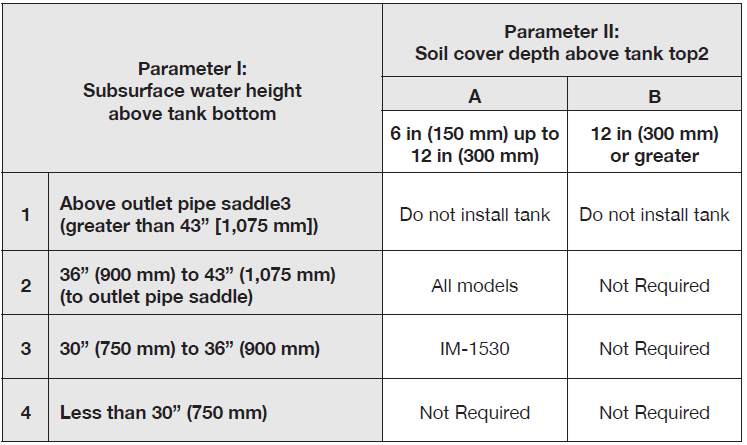When is Buoyancy Control Required?
Posted on by Jonathan Kaiser
Tank buoyancy control involves the strapping of anchor ballasts to either side of the tank base, offset by at least six inches. The weight of the anchor ballasts and the soil column above them help to ensure that the tank stays in the ground. This is typical in tank installations where the water table is high.
There are two main parameters to focus on when determining whether an Infiltrator tank will require buoyancy control. The first parameter is the subsurface water height above the bottom of the tank and the second parameter is the soil cover depth above the top of the tank. The minimum amount of soil cover depth above the top of an Infiltrator tank is 6 inches and the maximum is 4 feet.
- In areas where there are less than 30 inches of subsurface water and the soil cover depth is within the acceptable range of 6 inches to 4 feet, buoyancy control is not required.
- When the subsurface water height is between 30 inches and 36 inches, buoyancy control is only required for the IM-1530 tank when the soil cover depth is between 6 and 12 inches. Otherwise, no buoyancy control is required.
- If the subsurface water height is between 36 inches and 43 inches (or the outlet pipe saddle location), buoyancy control is required for all Infiltrator tank models if the soil cover depth is only between 6 inches and 12 inches. However, with 12 inches or greater of soil cover depth above the tank top, no buoyancy control is required.
- With the subsurface water height above the outlet pipe saddle (greater than 43”), do not install the Infiltrator septic tank. Infiltrator’s structural design prohibits tank installation when the water table is above the outlet pipe saddle.
Here’s a table to quickly reference the situations where buoyancy control may or may not be required. We’ve also developed this video to outline the requirements.

Watch: Buoyancy Control Guidance for Infiltrator Tanks
Contact us if you have any questions about when and how to use buoyancy control mechanisms when installing an Infiltrator tank.
About the Author:
 Jonathan Kaiser
Jonathan Kaiser
Project Engineer
Jon joined Infiltrator Water Technologies in 2016 as a Project Engineer after graduating with his B.S. in Environmental Engineering from the University of Vermont. He spends his time at Infiltrator working on decentralized wastewater treatment system designs, product regulation, and research and development initiatives. Jon also serves as the Vice-Chair of the National Onsite Wastewater Recycling Association (NOWRA) Emerging Professionals Committee and serves on the board of directors for the Connecticut Onsite Wastewater Recycling Association (COWRA).
